It’s a wrap at Laser 4.7 Youth World Champs
Published on August 23rd, 2019
Kingston, ONT (August 23, 2019) – The first day of racing for the 185 competitors from 35 countries participating in the 2019 ICLA Laser 4.7 Youth World Championships was a completely different day from the practice race day. As much as they lacked wind the day before, the first day of racing there was a surplus of wind. The first set of races were conducted with wind readings in the mid teens and gusts to the low twenties.
By the time the first set of races were completed, the winds had picked up to the high teens with gusts in the mid twenties. Later in the afternoon, the racers saw a steady 20 with gusts near 30 knots. This was, by all accounts, a “Kingston Day”.
It wasn’t survival conditions out there, but it was certainly a workout for the sailors. From the limited perspective one gets watching from the race committee boat, it was difficult to see what the determining factors were for success on the course. There was more than enough wind pressure all through the race area. Was it managing to take advantage of the bigger shifts? Avoiding adverse current? Downwind boat handling? Or was it about being physically strongest and able to hike the hardest?
Whatever the winning combination was, it was pretty clear that several sailors had it figured out. In both scheduled races completed in the girls fleet, Marilena Makri from Cyprus crossed the finish line first. During equipment inspection, Makri had said she was hoping for a strong breeze, and today showed exactly why.
Obviously, she was not alone in favoring those conditions. In the same two races, Italy’s Sara Savelli finished second each time. Following her was Anja von Allmen from Switzerland (with a fifth and a fourth), and then a trio of sailors from Great Britain – Abigail Childerly, Elizabeth Beardsall, and Coco Barrett.
On the boys side, with some pressure to try and secure enough qualification races (four required) during the regular schedule, three races were completed in both fleets. Matching the performance of Marilena Makri, there was one sailor who had a perfect afternoon, Roko Stipanovic from Croatia. With three first place finishes in the blue fleet, he showed he, too, can handle the breeze.
Derin Baytur (Turkey), Dmitry Golovkin (Russia) and Gasper Strahovnik (Slovenia) each won a race in the yellow fleet and finished 2nd or 3rd in at least one other race. In fact, the front of both fleets claimed their territory from the start of the day and didn’t let up. All of the boys sailors in the top 10 finished in the top 10 in each of their three races. There were a couple of other sailors who might have been up there in the standings as well – Iasonas Kefallonitis (Greece) and Mariano Cebrian (Spain) – but for a race that was scored at 60 (DNS or BFD) for each. So, look for them to potentially make a big leap up in the standings once a discard comes into play, after four races.
There would still plenty of racing to go, assuming favorable, or at least reasonable conditions.
On the second day of racing, with about 8 knots of wind from 190, both of the boys fleets were able to start under “U” flag with no one over early. This was certainly an improvement over the previous day.
It took quite a bit longer for the girls to get going, not because the girls tended to be a bit more aggressive on the start line. The wind that had settled in earlier at 190 started moving to the right, before eventually “settling” at 230. As it turns out this was a pattern that would repeat itself for most of the afternoon. The wind would settle in for a bit, and then swing left, or right, sometimes back to 190, then other times 230, or 210. The oscillations might come just a few minutes apart, or you might sail most of a 15 minute leg with a fairly consistent direction.
During the first race of the day, the wind picked up just a bit and for the rest of the afternoon speeds hovered around 10 to 12 knots, with occasional gusts in the mid to high teens and very brief lulls down to 8 or 9 knots. In those conditions, with the erratic shifts, it was important to get in phase. Sailors who managed to sail lifted tacks would be able to move to the top of the standings, while those who were unfortunate enough to sail from header to header would find themselves moving towards the back of the fleet.
While these were conditions that might be enjoyable for those who are skilled at reading the wind shifts, for race committee it might best be characterized as challenging, or frustrating, depending on your attitude at the moment and just how many wind shifts you had to endure while trying to get a square start line for one fleet. The record might have been four line resets for a single fleet as the wind seemed to oscillate every eight minutes. Just as sailors can get out of phase, so can race committee. The race officer didn’t give up though, and was able to get all the starts off with a fair line.
All three fleets finished three races on second day of the Championships, and the qualifying series for the boys is now complete.
Italian Niccolo Nordera was one of the very few who, even if he might have missed some shifts now and then, got enough of them right to finish with the day’s top performance: two firsts and a fourth, which moved him up from fifth to holding the overall lead in the Championship as the fleet moved into the finals series.
Most of the others top sailors in the boys division who could handle the bigger breeze of the previous day, had a pretty fair success in the more moderate conditions prevailing as well. Dmitry Golovkin from Russia and Croatian Roko Stipanovic also stayed in or near the front of the fleet and remained only a few points behind Nordera.
As anticipated, both Iasonas Kefallonitis (Greece) and Mariano Cebrian (Spain) were able to move up over quite a bit in the standings (over 30 places each), climbing into the top ten after a strong day, each finishing first in one of their races and being able to discard one score.
In the girls fleet, Lara Himmes of Spain had the best day 2 with three top ten finishes, moving her from 12th up to 2nd, just “behind” Italian Sara Savelli, who had the same point total as Himmes and now held the overall lead in the Championship on a tiebreaker. Marilena Makri (Cyprus) and Anja von Allmen both had at least two solid races to remain in the top five.
At the halfway point, the Championships were a long way from over.
The next day of racing the girls fleet had an opportunity to start first and sail the outer course, but that did not change their apparent lack of respect for the starting line. After a general recall under “U” flag, the first boat was over the line 40 seconds prior to the start. Another few came over about 15 seconds before the start, and then several more in the last five seconds. In all, seven offenders were removed from the fleet for being over early under black flag.
While the race committee was confirming numbers for display, the wind moved a bit to the right and the start line and course axes had to be reset about 10 degrees to the right. Whether the girls fleet had simply had the most aggressive starters removed, or the remaining sailors really did not want to share the fate of being disqualified, they were much more orderly during the next start sequence and they managed to get away clear.
In the boys gold, no one was looking to have their regatta hopes dashed by being on-course-side at the signal, and they had no problems remaining behind the line, starting clear the first time through their sequence. The boys silver fleet was not quite so concerned and had to be reigned in with a general recall under uniform flag, but they were a bit more cautious once the black flag was displayed on the second start attempt. And so all three fleets were spread nicely across the trapezoid course.
The wind was a bit steadier than the previous day – not as many wind shifts to exploit (or suffer), and work for the Race Committee was therefore a bit easier as well. With good wind strength that built up throughout the afternoon up to the mid teens, conditions were very good for an enjoyable day on the water. The girls fleet was able to pick up one additional race to get back on schedule, and they were able to do so without any more sailors being disqualified for being over the start line early.
When the wind is relatively stable with a good breeze from a fairly consistent direction, and there is a modest consistent current, there wasn’t much of a story to tell about conditions.
In the girls fleet, Swiss sailor Anja von Allman had a superb day, finishing with two thirds and a second. Although she had not yet won a race, she now lead all sailors in the girls division. Her lowest finish so far had been 12th, which is quite an accomplishment in the varied conditions that have been encountered in the past three days of racing. Following her in the standings is Marilena Makri from Cyprus, who moved up one place into second with two more race wins in the second and third races.
Lara Himmes (Spain) won the opening race of the day, and sat at fourth, one point behind Italian Sara Savelli who had two more top five finishes in the three races completed on day three of racing.
In the boys gold fleet, sailors seemed to have mixed results in their two races, with some doing reasonably well in the first of two races and not quite so well in the second, while others came back strong in the second race after struggling a bit in the first.
Only one sailor in the gold fleet had two top ten finishes, Roko Stipanovic from Croatia, who won the second race of the day after finishing a solid 9th in the first race, moving him from third to second overall. Italian Niccolo Nordero continued his consistency with a 12th place finish (discarded) and a 2nd, and so maintains the overall lead in the gold fleet. Slovenian Gaspar Strahovnik is not far behind in third, and then there is a somewhat crowded field from about 4th to 12th.
There were four more scheduled races for all fleets, and so there is time and opportunity for some changes in the standings.
On the penultimate day of the regatta, the prevailing breeze was farther right than was seen all week (275) but with good speed in the low double digits.
The girls fleet started their first race of the day with a nice, straight line. Unfortunately they started their race twenty seconds before the actual start signal. No more Mr. Nice Guy from the race officer after the fleet is recalled – it will be a black flag from now on. The boys gold fleet also had to be reeled in once under uniform flag, but they managed to get a clear start under black flag. Only the silver fleet kept themselves in check until the start signal sounded.
The breeze was oscillating (275-260), not only in direction but also strength (14 knots to 8), and, puffs seemed to be coming in from the right. With three fleets operating in various parts of the race area, making a small change to the course was not going to be an option. Sailors would need to deal with current, wind shifts and finding good pressure.
Everything seemed to be set up for a relatively easy day of race management, but nature seems to have a way of mocking your hopes. First a modest front came through with a wind direction of 240. Then when the fleets were all back on course for race two, the thermal kicked in bringing the wind direction down to 225. Race committee wasn’t able to get gate 3 reset on the new direction without causing a problem for boats on the course at the time.
Unfortunately, it made life even more difficult for race committee as the afternoon wore on because the trapezoid on the previous direction was now more of a rectangle with the new wind. It wasn’t necessarily pretty, but with careful timing, they made it work.
With the thermal coming into play, wind speeds again began to pick up, first to the mid teens and then on the final race for each of the three fleets, it was in the high teens and low twenties. Given the prognosis for poor conditions the following day, race committee wanted to get in three good races with good conditions for sailors, and this they managed to do.
If the leaders felt any pressure coming in to the day, it didn’t show on the water. In the girls fleet, Swiss sailor Anja von Allman had her best day of the Championship, winning the first race of the day (her first win of the regatta), and securing two second place finishes. Her exceptional performance capped off a remarkable week where her lowest finish has been 12th.
Her counterpart in the boys gold fleet, Italian Niccolo Nordera, likewise performed remarkably well when the pressure was on, earning a first place in between two top five finishes. In fact, he placed in the top five in every single race but one, so far.
With only one race scheduled on the final day to complete the Championship, there is no one who can catch either of the leaders, revealing who the new World Champions will be.
Although the two World Champions had already been determined coming into the final day of racing, there was still a lot on the line for some of the competitors, and race committee made a determined effort to get in one more race. The trouble is, nature wasn’t cooperating.
The forecast was for a dying north breeze to eventually be replaced by a thermal breeze after swinging through the west, with light and variable winds. Unfortunately the forecast was pretty accurate. The winds were light (zero to eight knots, averaging around three). And they were variable (from 070 through 350 and down to 220, with oscillations regularly greater than 70 degrees).
With hopes for suitable conditions fading as the afternoon wore on, the signal boat hoisted AP over A flags, which the sailors all cheered and then started heading back to shore.
But no regatta is complete without an abandonment being followed by a new breeze appearing shortly afterwards. And sure enough, the new breeze appeared from the south and gave all the sailors a pleasant push back to the harbour.
The final day of racing concluded at the 4.7 Youth World Championships the way the regatta began, with no races completed. But in-between, there were 11 really strong races in great conditions. The two winners in the boys and girls divisions were superb from beginning to end and never had a bad race, and that is how you earn a World Champion title.
The 4.7 Youth World Champions are:
Anja von Allmen (Switzerland) 2019 4.7 Youth Girls World Champion
Niccolo Nordera (Italy) 2019 4.7 Youth Boys World Champion
Event Details – Results Girls – Results Boys Gold Fleet – Results Boys Silver Fleet
Source: ILCA


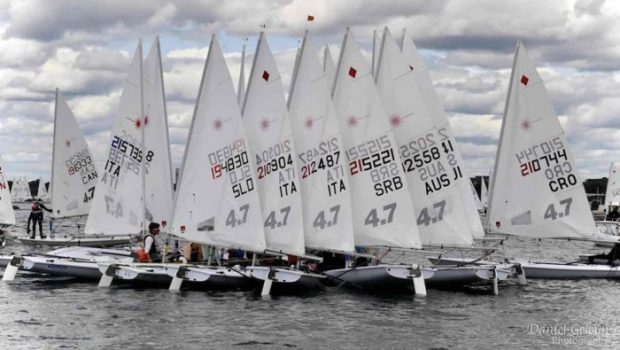


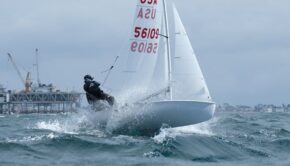
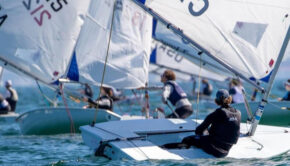
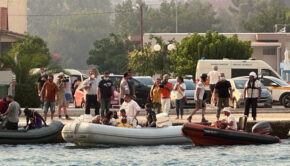
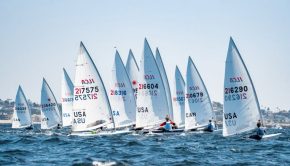
 We’ll keep your information safe.
We’ll keep your information safe.